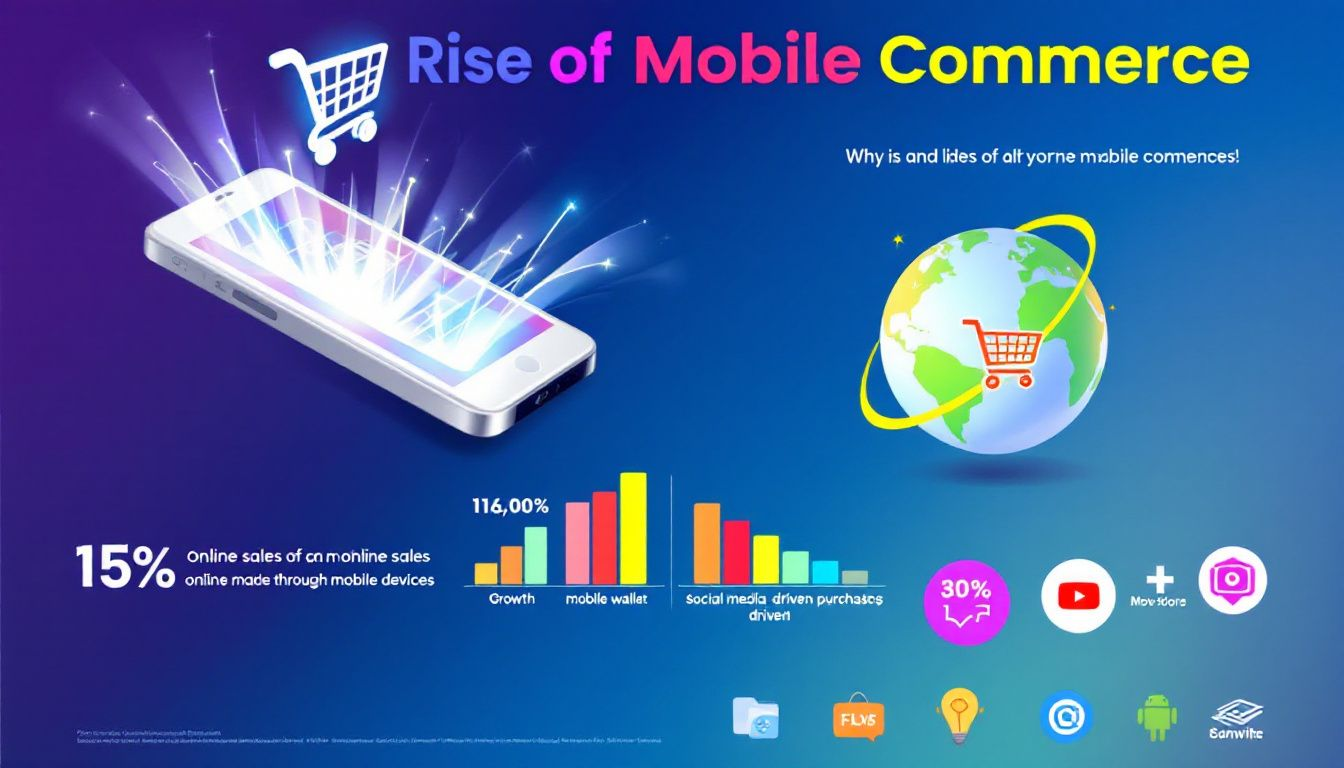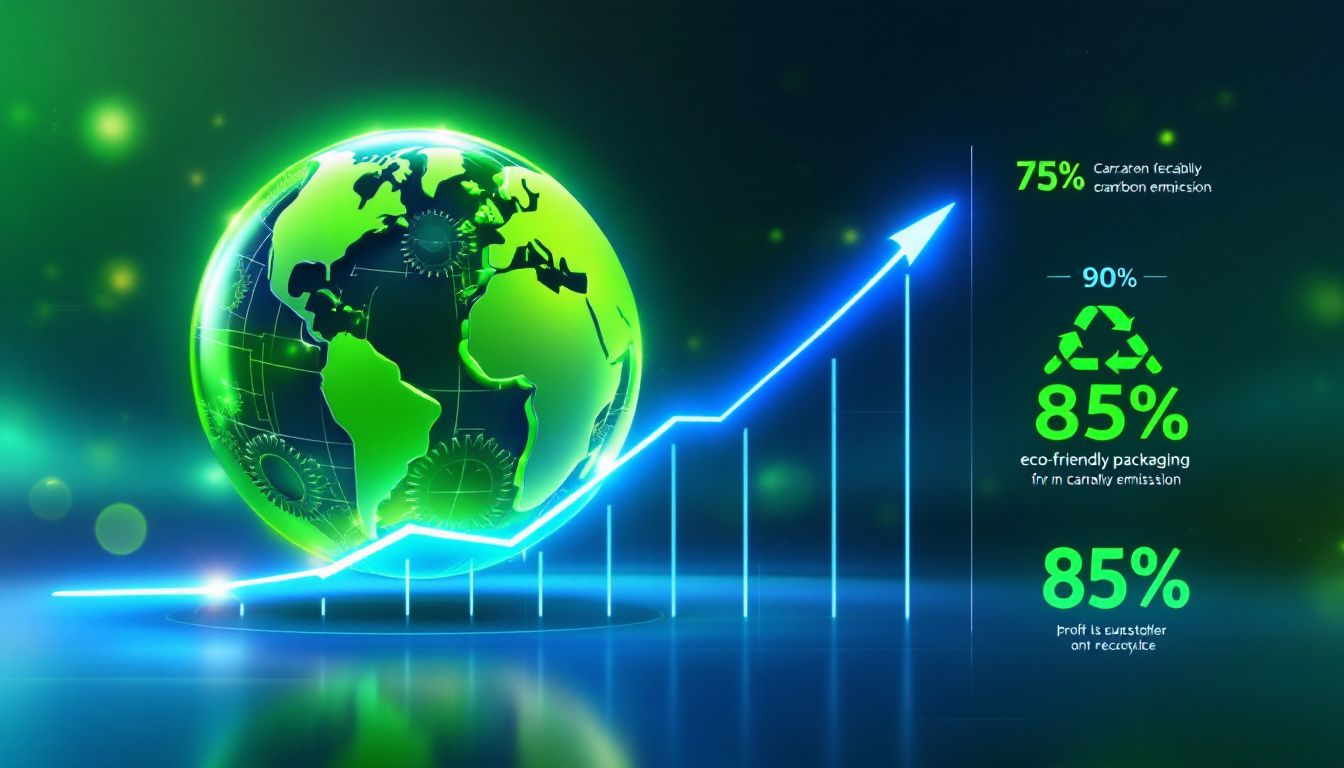Top 5 e-Commerce Trends to Watch in 2025 for Online Retailers 🤑
The e-commerce landscape is set to transform by 2025. To help you stay competitive, this article explores the Top 5 E-Commerce Trends to Watch in 2025, focusing on how e-commerce platforms are evolving to meet new consumer expectations. Discover the innovations that will drive online retail forward.
Key Takeaways
Mobile commerce is expected to dominate global e-commerce sales, highlighting the need for online retailers to enhance mobile shopping experiences for better customer satisfaction and loyalty.
The integration of augmented reality and personalised AI tools offers unique opportunities for e-commerce businesses to boost engagement and reduce return rates through immersive shopping experiences.
Sustainability is a growing consumer expectation, prompting e-commerce businesses to adopt eco-friendly practices, from sustainable packaging to carbon-neutral shipping, to build brand loyalty.
The State of Global E-commerce
The global e-commerce market is on a trajectory of remarkable growth, with reputable sources projecting it will reach over $7 trillion by 2025. This continued surge, driven by robust double-digit gains year over year, underscores the increasing number of online shoppers and the rapid technological advancements. Mobile commerce is a particularly significant contributor to this expansion, as more consumers rely on their smartphones for convenient, personalised shopping experiences—especially in regions where mobile usage already surpasses traditional desktop activity.
As the e-commerce industry continues to evolve, businesses must stay ahead of the curve by adopting the latest e-commerce trends and strategies. The dynamic nature of the global e-commerce market presents both opportunities and challenges, making it crucial for online businesses to remain agile and innovative. By leveraging cutting-edge technologies and understanding consumer behaviour, online retailers can position themselves for sustained success in this competitive landscape.
Global E-commerce Sales Projections
Global e-commerce sales are set to soar, with one source estimating they will reach an impressive $5.5 trillion by 2027 (at a CAGR of around 10%). Meanwhile, other reputable projections (such as eMarketer) suggest the market could surpass $7 trillion by 2025. Although these figures vary by data provider, the consistent takeaway is a strong upward trajectory fuelled by the increasing adoption of online shopping worldwide, particularly in emerging markets.
For e-commerce businesses, this growth presents a golden opportunity to tap into new regions and expand their customer base. Investing in the latest technologies and strategies is essential to capitalise on these trends. From enhancing mobile shopping experiences to integrating advanced AI tools, businesses must innovate to meet the evolving demands of online shoppers and drive e-commerce sales.
Regional Growth Leaders: LATAM and the Philippines
Latin America (LATAM) and the Philippines are emerging as powerhouses in the e-commerce market, showcasing impressive growth rates that outpace many other regions. LATAM is expected to witness a 22% growth in e-commerce sales between 2023 and 2026, with the region’s total combined online retail sales projected to exceed $700 billion. This expansion is driven by increasing internet penetration, a burgeoning middle class, and a growing preference for online shopping.
The Philippines, on the other hand, is set to become the fastest-growing e-commerce market in the world, with an anticipated 24.1% growth in e-commerce sales in 2023. This rapid expansion is attributed to the country’s young, tech-savvy population and the increasing availability of affordable mobile devices.
For e-commerce businesses, these regions represent lucrative opportunities. By tailoring strategies to meet the unique needs and preferences of consumers in LATAM and the Philippines, businesses can tap into these high-growth markets and drive significant online sales.
The Rise of Mobile Commerce

Mobile commerce is poised to dominate the global e-commerce market, with projections indicating it will account for nearly 73% of global e-commerce sales by 2025—making it a crucial e-commerce trend to watch. As consumers increasingly use their smartphones to shop online, the need for responsive design and easy navigation becomes paramount. Enhancing mobile shopping experiences not only boosts customer satisfaction but also encourages repeat purchases and builds brand loyalty.
In 2023, 80% of global consumers accessed retailer websites via smartphones while shopping in-store, highlighting the shift towards mobile-first shopping behaviours. Online retailers adapting to these changes must incorporate effective personalisation and versatile payment processing to manage holiday season crowds and enhance the overall user experience in their online store.
Mobile Shopping Experiences
Enhancing mobile shopping experiences is more than just a trend; it’s a necessity for staying competitive as an online business. Consumers today expect seamless, personalised shopping that is both convenient and engaging. Features like virtual try-ons and 3D product displays are becoming increasingly popular, as they offer interactive navigation that significantly improves user satisfaction.
A relatively young and tech-savvy population in many markets contributes to the growth of mobile commerce, emphasising the need for tailored shopping experiences. AI chatbots in mobile apps further optimise the customer journey by understanding context and providing personalised product recommendations.
One-Click Checkout
Streamlining the checkout process is crucial for reducing cart abandonment in online shopping. One-click checkout has revolutionised purchasing by allowing customers to complete transactions quickly and efficiently. In 2022, 49% of global e-commerce transactions occurred through digital wallets, highlighting the importance of offering multiple payment options to cater to diverse consumer preferences.
Moreover, 13% of customers abandon carts due to insufficient payment methods, underscoring the need for streamlined checkout options. By 2023, it is estimated that 40% of e-commerce consumers will utilise Buy Now, Pay Later options, indicating a shift towards flexible payment solutions.
Augmented Reality Revolutionises Online Shopping

Integrating augmented reality (AR) into online shopping is revolutionising the e-commerce landscape by enhancing product visualisation and creating immersive experiences—making it a significant e-commerce trend. AR allows online shoppers to see products in their real-world environments, bridging the gap between online and in-store shopping. This technology builds customer trust and significantly boosts engagement.
By 2025, AR users in the US are expected to surpass 100 million, with over 50% of consumers already using AR features when shopping. With 40% of consumers willing to pay more for products if they can use AR first, e-commerce businesses have a unique opportunity to differentiate themselves.
Virtual Try-Ons
Virtual try-ons are one of the most exciting applications of AR in ecommerce. This feature lets customers see how clothing and accessories look on them before buying—providing a bridge between online and in-store experiences. Virtual fitting rooms improve purchase confidence, leading to higher satisfaction and lower return rates.
3D Product Visualisations
3D product visualisations are transforming how consumers interact with products online. By offering 360-degree views and detailed product descriptions, retailers can provide a more engaging shopping journey. Accurate product visualisation not only enhances satisfaction but also helps reduce return rates by clarifying product details before purchase.
AI-Powered Personalisation

Artificial intelligence (AI) is playing a pivotal role in providing personalised experiences, making it a key e-commerce trend. AI analyzes real-time customer behaviour and tailors recommendations to individual needs, boosting satisfaction and loyalty.
Voice search and conversational AI are also on the rise, enhancing interactions and support—particularly in mobile commerce. By leveraging AI, e-commerce businesses can adapt more quickly to market changes and deliver next-level shopping experiences.
Personalised Recommendations
Personalised recommendations can significantly increase customer satisfaction and loyalty. In 2022, 62% of consumers wanted companies to anticipate their needs, highlighting the demand for tailored shopping. Brands investing in AI tools often report rises in CTR, time on site, and Net Promoter Scores.
Automated Customer Support
Automated customer support, powered by AI, is an essential tool for e-commerce businesses. AI chatbots can instantly respond to inquiries and resolve common issues, dramatically improving the online shopping experience. By 2026, AI-powered tools are predicted to reduce the need for customer service staff by 20–30%, reflecting both efficiency and cost-effectiveness.
Social Commerce Integration

Social commerce is rapidly transforming the e-commerce landscape, with platforms like Instagram, TikTok, and Facebook evolving into key shopping venues—making it a crucial e-commerce trend. The social commerce market size was $945.92 billion in 2023 and is set to expand significantly by 2025. This growth is driven by in-app purchase options that simplify the buying process and enhance convenience.
Live-streaming shopping has also become an exciting development, letting businesses showcase products, answer queries, and offer promotions in real time—boosting engagement.
Influencer Collaborations
Influencer collaborations have become a cornerstone of social commerce, with 51% of e-commerce brands contributing to the influencer market. When influencers feature friends or family in sponsored posts, audience engagement often increases, showcasing the power of relatable content. This strategy effectively builds trust and reaches targeted audiences, making it vital for modern e-commerce marketing.
In-App Purchases
In-app purchases are transforming how consumers shop online. Social media platforms now integrate direct purchase options, letting users buy without leaving the app. TikTok Shop, for instance, is rapidly becoming a major player in online sales. As more e-commerce businesses adopt this model, customer engagement and conversion rates climb.
E-commerce Business Models and Strategies
As the e-commerce industry continues to evolve, businesses must adapt their models and strategies to remain competitive. One noteworthy trend is the rise of subscription-based models, which give customers a convenient, personalised shopping experience while providing businesses with steady recurring revenue.
Growth in Subscription-Based Models
The global subscription e-commerce market is experiencing exponential growth, projected to expand from $199.41 billion in 2023 to $400.63 billion by 2025. This surge reflects consumers’ rising demand for convenience and personalisation. By offering curated boxes, replenishment services, or exclusive product access, e-commerce businesses can create long-term customer relationships and drive sustained growth.
Expansion of Direct-to-Consumer Model
The Direct-to-Consumer (DTC) model is revolutionising the e-commerce industry by allowing brands to forge direct and unmediated relationships with their customers. By eliminating intermediaries, DTC brands can offer competitive pricing and maintain control over the entire customer journey, from product development to delivery. This direct approach not only enhances the shopping experience but also enables brands to gather valuable customer data, which can be leveraged to further personalize and improve the overall experience.
In recent years, the DTC model has gained significant traction, with many brands adopting this approach to connect more effectively with their customers. According to a report by Digital Commerce 360, the DTC market is projected to reach $175 billion by 2025, growing at a compound annual growth rate (CAGR) of 16.9%. This impressive growth is driven by the increasing demand for personalised and seamless shopping experiences—an area where the DTC model excels.
Logistics and Delivery
Logistics and delivery are critical components of the e-commerce industry, directly impacting the customer’s shopping experience. With the rise of online shopping, customers now expect fast and reliable delivery options, posing a significant challenge for online retailers. According to a report by McKinsey, the average delivery time for e-commerce orders is around 3–5 days, but there is growing demand for same-day or next-day delivery.
To meet these heightened expectations, e-commerce businesses are investing heavily in logistics and delivery infrastructure—partnering with third-party logistics providers, implementing advanced warehouse management systems, and leveraging data analytics to optimise routes. By enhancing logistics and delivery capabilities, e-commerce businesses can increase customer satisfaction, reduce return rates, and ultimately drive revenue growth. As the e-commerce industry continues to evolve, efficient logistics and delivery will remain key differentiators for online retailers.
Sustainability in E-commerce

Sustainability has become a top priority for many e-commerce businesses, as customers increasingly expect brands to act responsibly toward the environment and society. Multiple reports corroborate this shift:
Nielsen data shows 81% of customers feel strongly that companies should help improve the environment, with 73% willing to pay more for sustainable products.
Another global survey finds 66% of customers willing to spend extra on eco-friendly options.
Gen Z and Millennials in particular are driving this demand. By prioritising sustainability—through ethical sourcing, recycling initiatives, and eco-friendly practices—brands can increase trust, drive loyalty, and secure repeat purchases from environmentally conscious consumers.
Sustainable Packaging
Sustainable packaging is crucial for reducing the environmental impact of e-commerce. Many retailers are moving toward biodegradable or recyclable materials to minimize waste. Companies like Returnity exemplify innovative approaches to reducing e-commerce packaging waste.
Carbon-Neutral Shipping
Carbon-neutral shipping is becoming a standard practice among online retailers. By offsetting carbon emissions—through renewable energy investments, carbon credits, or efficiency improvements—businesses demonstrate a real commitment to reducing ecological footprints. This appeals to eco-conscious shoppers looking for responsible brands and enhances overall brand reputation.
Summary
As we venture into 2025, the e-commerce landscape is poised for significant transformations driven by trends like mobile commerce, augmented reality, AI-powered personalisation, social commerce integration, and sustainability. The continued rise of mobile underscores the importance of seamless, personalised mobile shopping experiences to capture growing smartphone-driven markets. Augmented reality bridges online and offline experiences, building consumer trust and satisfaction.
AI-powered personalisation enhances loyalty by catering to individual shopper needs, while social commerce integrates purchasing directly into platforms like TikTok and Instagram, broadening brand reach. Finally, sustainability is a clear priority for modern consumers, motivating online retailers to embrace eco-friendly packaging and carbon-neutral shipping. By staying on top of these trends, e-commerce businesses will be well-positioned for success in this ever-evolving industry.
Frequently Asked Questions
Why is mobile commerce expected to dominate the e-commerce market by 2025?
Mobile commerce is set to lead the e-commerce market by 2025, capturing around 73% of it, thanks to the increasing reliance on smartphones for convenient and personalised shopping experiences, making it a crucial e-commerce trend. Embracing mobile commerce means you’ll be part of a dynamic and thriving market!
How does augmented reality enhance the online shopping experience?
Augmented reality transforms online shopping by letting you visualise products in your space, making the experience immersive and building trust in your purchase decisions, making it a significant e-commerce trend. Embrace the possibilities and enjoy a more interactive shopping journey!
What role does AI play in e-commerce personalisation?
AI significantly enhances e-commerce personalisation by analysing customer behaviour to deliver personalised recommendations, leading to improved satisfaction and loyalty, making it a key e-commerce trend. Embracing this technology can create a shopping experience that feels uniquely tailored just for you.
How are social media platforms integrating e-commerce?
Social media platforms are embracing e-commerce by allowing direct purchases within the app, making shopping more convenient and enjoyable for users, making it a significant e-commerce trend. This integration not only streamlines the buying process but also enhances your shopping experience!
Why is sustainability important for e-commerce businesses?
Sustainability is crucial for e-commerce businesses as it attracts environmentally conscious consumers willing to pay more for eco-friendly products, ultimately boosting brand loyalty and sales, making it a key e-commerce trend. Embracing sustainable practices not only benefits the planet but also positions your business for future growth and success!